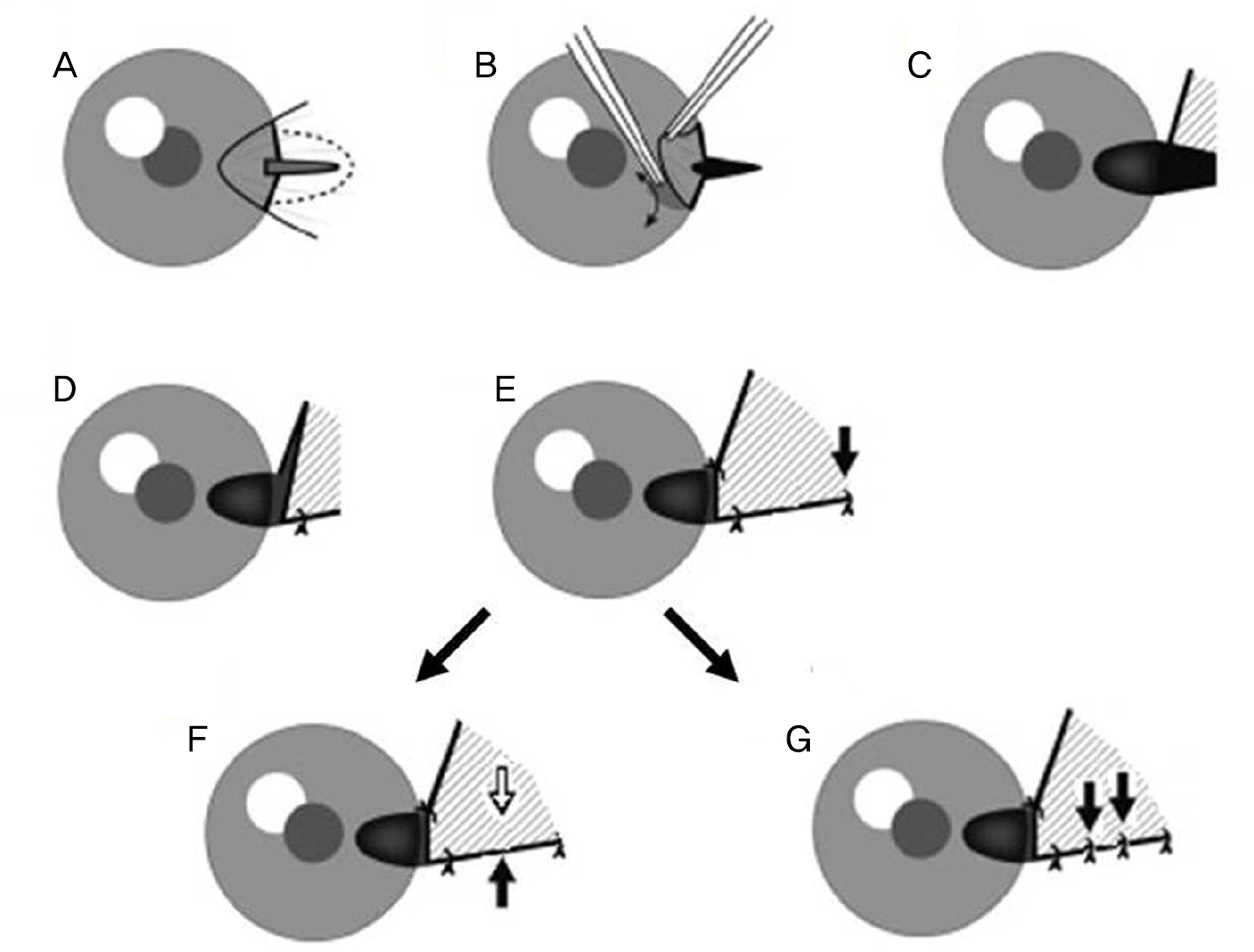J Korean Ophthalmol Soc.
2017 Jul;58(7):797-803. 10.3341/jkos.2017.58.7.797.
Clinical Outcomes after Use of Fibrin Glue Using a Modified Mini-flap Technique for Pterygium Surgery
- Affiliations
-
- 1The Institute of Vision Research, Department of Ophthalmology, Yonsei University College of Medicine, Seoul, Korea. SEOKY@yuhs.ac
- 2Corneal Dystrophy Research Institute, Department of Ophthalmology, Yonsei University College of Medicine, Seoul, Korea.
- KMID: 2387153
- DOI: http://doi.org/10.3341/jkos.2017.58.7.797
Abstract
- PURPOSE
To analyze the long-term clinical outcomes after use of fibrin glue using a modified mini-flap technique for pterygium surgery.
METHODS
This study is a retrospective, clinical outcome study of 148 subjects that underwent the modified mini-flap technique with fibrin glue from January 2014 to August 2015. We analyzed the recurrence rate and surgical time of modified mini-flap surgery with fibrin glue. We also analyzed associating factors between the recurrence group and non-recurrence group who underwent the same surgery technique.
RESULTS
Mean age was 60.2 ± 1.1 (ranging from 29 to 86) years, and mean surgical time was 11.8 ± 5.8 (ranging from 5 to 36) minutes. The recurrence rate of pterygium patients who underwent the fibrin glue using a modified mini-flap technique was 4.0% (6/148), and the re-operation rate was 0.6% (1/148). From the comparison of associating factors between recurred and non-recurred groups, the recurred group was younger, had more severe disease, and had a higher rate of bilaterality than the non-recurred group (p < 0.05).
CONCLUSIONS
The new approach using fibrin glue with a modified mini-flap technique shows a low recurrence rate compared to the other type of pterygium surgery. The use of fibrin glue shortened operation time and decreased patient discomfort due to fewer remnant sutures. Fibrin glue use in a modified mini-flap technique can be considered as a feasible surgical option for pterygium patients.
Keyword
MeSH Terms
Figure
Reference
-
References
1. Youngson RM. Recurrence of pterygium after excision. Br J Ophthalmol. 1972; 56:120–5.
Article2. Wong VA, Law FC. Use of mitomycin C with conjunctival auto-graft in pterygium surgery in Asian-Canadians. Ophthalmology. 1999; 106:1512–5.
Article3. Young AL, Leung GY, Wong AK. . A randomised trial comparing 0.02% mitomycin C and limbal conjunctival autograft after ex-cision of primary pterygium. Br J Ophthalmol. 2004; 88:995–7.
Article4. Akura J, Kaneda S, Matsuura K. . Measures for preventing re-currence after pterygium surgery. Cornea. 2001; 20:703–7.
Article5. Kim M, Chung SH, Lee JH. . Comparison of mini-flap techni-que and conjunctival autograft transplantation without mitomycin C in primary and recurrent pterygium. Ophthalmologica. 2008; 222:265–71.
Article6. Park SY, Han KE, Seo KR. Recurrence after modified mini-flap technique for pterygium surgery. J Korean Ophthalmol Soc. 2012; 53:1419–24.
Article7. Tsim NC, Young AL, Jhanji V. . Combined conjunctival rotational autograft with 0.02% mitomycin C in primary pterygium surgery: a long-term follow-up study. Br J Ophthalmol. 2015; 99:1396–400.
Article8. Hirst LW. The treatment of pterygium. Surv Ophthalmol. 2003; 48:145–80.
Article9. Koranyi G, Seregard S, Kopp ED. The cut-and-paste method for primary pterygium surgery: long-term follow-up. Acta Ophthalmol Scand. 2005; 83:298–301.
Article10. Kim HH, Mun HJ, Park YJ. . Conjunctivolimbal autograft using a fibrin adhesive in pterygium surgery. Korean J Ophthalmol. 2008; 22:147–54.
Article11. Kheirkhah A, Casas V, Sheha H. . Role of conjunctival in-flammation in surgical outcome after amniotic membrane trans-plantation with or without fibrin glue for pterygium. Cornea. 2008; 27:56–63.
Article12. Fernandes M, Sangwan VS, Bansal AK. . Outcome of ptery-gium surgery: analysis over 14 years. Eye (Lond). 2005; 19:1182–90.e1.
Article13. Han SB, Jeon HS, Kim M. . Risk factors for recurrence after pterygium surgery: an image analysis study. Cornea. 2016; 35:1097–103.e1.
- Full Text Links
- Actions
-
Cited
- CITED
-
- Close
- Share
- Similar articles
-
- Recurrence after Modified Mini-Flap Technique for Pterygium Surgery
- Conjunctival Mini-flap Technique and Conjunctival Autotransplantation in Pterygium Surgery
- Clinical Outcomes between Amniotic Membrane Transplantation and Conjunctival Autograft Using Fibrin Glue for Pterygium Surgery
- The Use of Fibrin Glue for Conjunctival Autotransplantation in Pterygium
- Clinical Outcomes of Endonasal Dacryocystorhinostomy Using Fibrin Glue for Lacrimal Sac and Nasal Mucosal Flaps



